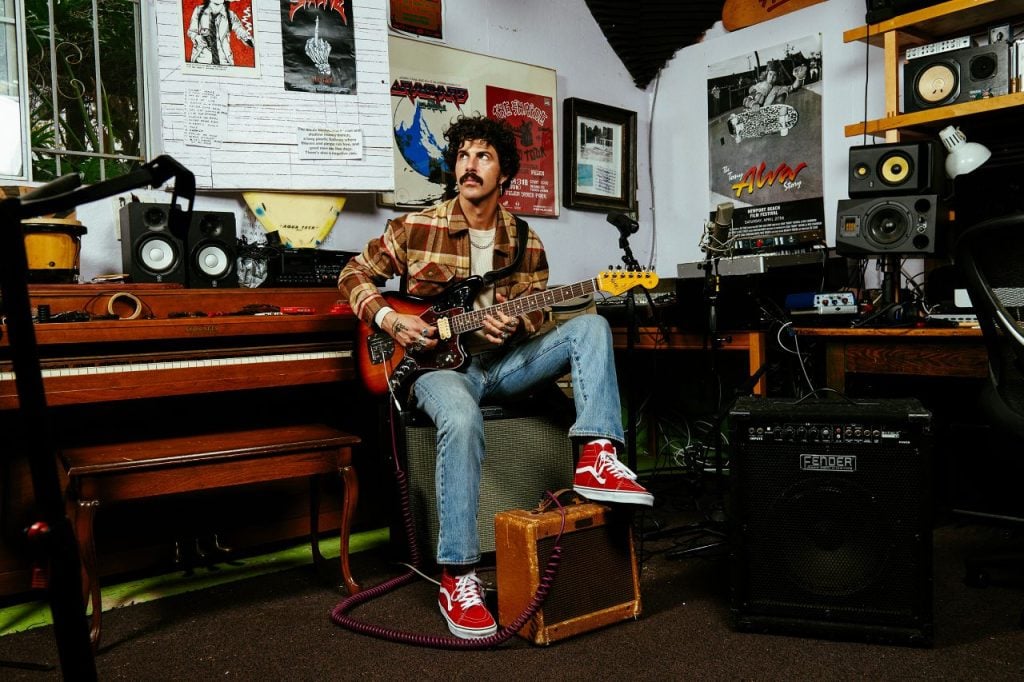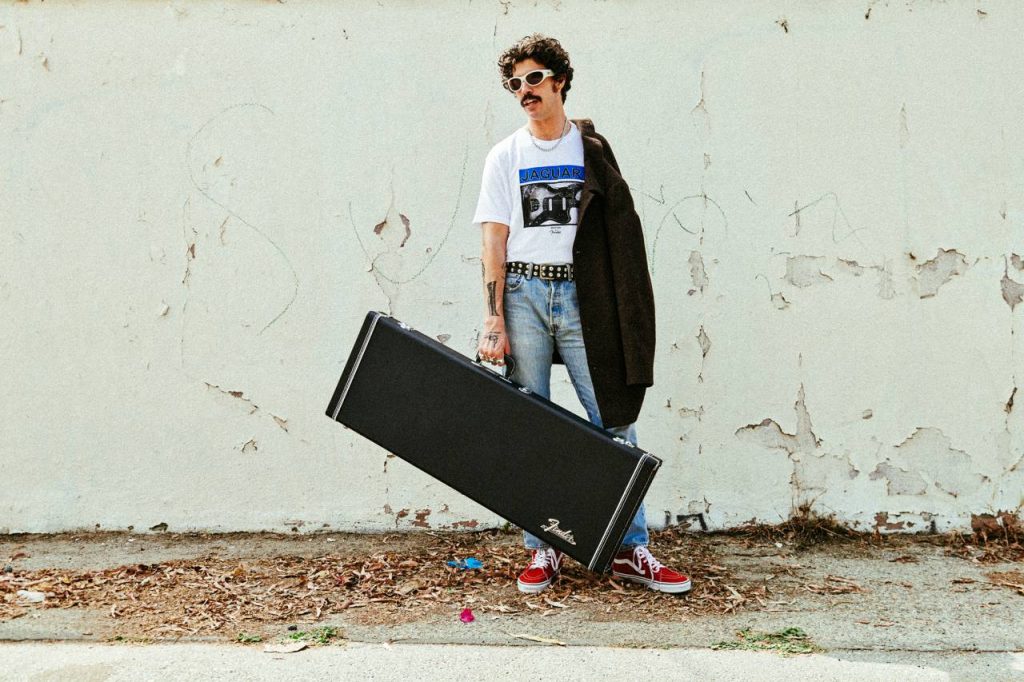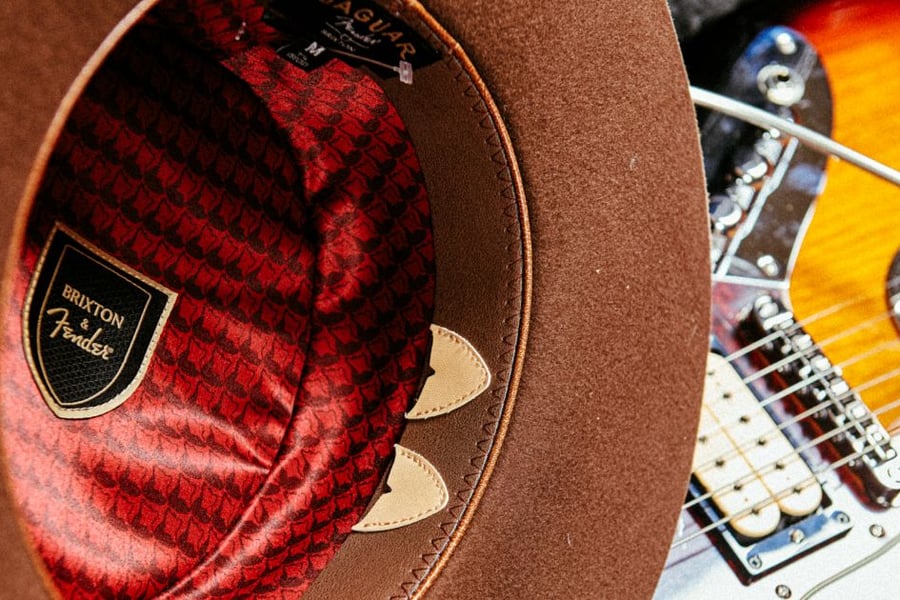Southern California-based clothing brand Brixton has launched a new collection in collaboration with Fender and musician Josh Landau to commemorate the 60th anniversary of the Jaguar guitar, the weapon of choice of masters of noise like Johnny Marr and Kurt Cobain.
“The synergy between Brixton and Fender only gets stronger as we hope to inspire musicians and creatives alike through our continued collaborations,” says Richard Bussey, Fender Vice President, Accessories, Lifestyle & Licensing, “our shared ethos of bringing music, creativity and innovation to the forefront of design – along with a storied history of welcoming together diverse cultures and creators – is a special moment for us especially as we celebrate the 60th Anniversary of the Jaguar guitar.”
In 1962, Rolling Stone Magazine didn’t exist, and The Rolling Stones had just made their debut at London’s Marquee Club as the opening act for Long John Baldry. Western Samoa became independent from New Zealand, and in the U.S, the supreme court ruled that photographs of nude men were not obscene, decriminalizing nude male pornographic magazines.
60 years ago, the twist craze still ruled U.S. charts, with Chubby Checker’s ‘The Twist’ hitting #1 for the second time. West Side Story won the Oscar for Best Picture and Marilyn Monroe was found dead in her home in Los Angeles from an overdose of sleeping pills and chloral hydrate. 1962 also saw the U.S. and the Soviet Union locking horns in the Cuban Missile Crisis, until now, the last time the world had come close to a nuclear confrontation.
This was the hectic planet where the Fender Jaguar was born. Fender introduced the guitar in 1962 as the fourth and last of the company’s original guitar lineup, preceded by the mythic Telecaster (1951), the Stratocaster (1954), and the Jazzmaster (1958).

Borrowing many design elements from the Jazzmaster, the Jaguar was intended as Fender’s feature-packed, top-of-the-line model. Both guitars sported similar aesthetics, but the Jazzmaster had a warmer and rounder sound, while the Jaguar sounded crispier and punchier. Meant to be a comfortable guitar to play, especially for musicians with smaller hands, the Jaguar sported a shorter, 24-inch scale, 22-fret neck. Distinctively, it featured two tall, narrow, single-coil, shielded pickups that delivered a hot, aggressive tone less prone to electrical interference than its older, more famous siblings.
Love Music?
Get your daily dose of everything happening in Australian/New Zealand music and globally.
The Jaguar’s circuitry was also the most elaborate of any Fender guitar at the time, with varied switching options and eight onboard controls, giving players the choice to alternate between rhythm and lead tones.
Despite early popularity, particularly among surf rock musicians —Beach Boy Carl Wilson is seen playing a white Jaguar in the clip of the song ‘Monkey’s Uncle’ with Mouseketeer Annette Funicello— a series of factors confabulated against it. The massive popularity of its established, and less expensive siblings, plus the downfall of surf rock courtesy of the British invasion of ‘64 relegated the prodigal son to the status of black sheep. After a 13-year lackluster run, the guitar was finally discontinued in 1975.
Curiously, the Jaguar’s disappearance from shelves coincided with the apparition of a new, fiery movement. Punk was a manifestation of the dissatisfaction and anger that young people felt towards a system that had failed to deliver the promises of prosperity of the post-war recovery years. Unable to afford a Stratocaster or a Telecaster, budding musicians started scouring pawn shops in Los Angeles, New York, and London looking for an axe that mirrored their anxieties and befitted their meager budgets. Those marked-down, dust-covered Jaguars found a second lease of life in the hands of a generation fed up with institutions and norms, eager to scream their dissatisfaction at the top of their lungs. Tom Verlaine from Television, Lydia Lunch from Teenage Jesus and the Jerks, and Will Sergeant from Echo & The Bunnymen were among the first of that wave of unorthodox rockers to adopt the jangling roar of Jaguar into their sets.
“The Jag suited the way I was playing, the way I’d evolved as a guitar player,” says Johnny Marr, the influential guitarist of The Smiths, “…at the same time all the old stuff, all my old riffs, everything sounded absolutely right on the Jag. [It] covered loads of basses I had used other guitars for.”

From that point on, the ostracised Fender Jaguar became a key element in the evolution of post-punk, new wave, shoegaze, and the alternative rock movements of the ‘80s and ‘90s. The chrome-clad, space-age-shaped instrument became the preferred tool for bands like Siouxsie and the Banshees, Ultravox, Thee Headcoats, and Sonic Youth. The Jaguar’s trademark jangly, bright sound has continued to impact rock’n’roll to our days, utilized in a wide aural spectrum that goes from raucous to the mellifluous, with contemporary torchbearers like Troy Van Leeuwen of Queens of the Stone Age, Emily Kokal of Warpaint, and Kevin Shields of My Bloody Valentine.
“We were in New Orleans, years ago, this is way back, and I had gone out to do my laundry and I passed by this pawn shop, and there’s this Jag in the window,” reminisces Noel Hogan of The Cranberries, “it looks beat up to hell you know. Went in, didn’t even play the thing, just bought it. We were on tour over in States at the time and I just just started using it.”
It’s no wonder that Fender Jaguar, the quintessential guitar for the contrarian, has partnered with Brixton, the lifestyle brand for the adventurous and defiant.
Named after The Clash’s song ‘The Guns of Brixton’, the famed brand started out in a garage in Oceanside CA, a brainchild of a trio of friends inspired by music and counterculture with a burning desire to shake the fashion industry.

Brixton co-founder David Stoddard was a 20-year-old when he landed a job at TransWorld’s warehouse, earning $6 an hour. (TransWorld, the international skateboarding magazine based in California.) From there he slowly worked his way up to an advertising sales position where he stayed for seven years. The idea of starting his own company stirred in his head for long, and his work at TransWorld allowed him to develop the know-how and necessary contacts to enact his dream.
“Jason Young, who I worked with [at TransWorld] and played music with, said, ‘Hey, let’s do this together.’” recalls David Stoddard in an interview with The Hundreds, “Jason came to me and presented Mike [Chapin], my eventual third business partner, who had an MBA in finance. It was kind of the perfect triangle. I had the brand, vision, idea – Jason would have logistic sales, and Mike would handle finances.”
In 2004, David Stoddard, Jason Young, and Mike Chapin started Brixton, each one of them putting into the business ten grand from their own cash. The company began running from Stoddard’s garage offering just hats, a catalog that over the years has expanded to a full range of apparel and clothing that includes jackets, fleece, tops, tees, bottoms, and accessories available in over 30 countries.
Timeless designs inspired by the past, built to live in the present.
To celebrate the 60th Anniversary of the Fender Jaguar Guitar, Brixton will release a limited edition fashion collection inspired by the underground grunge scene of the ’90s, featuring large plaids, textured fabrics, and ’90s art prints. The effort aims to homage the style of the quintessential artists that have helped to shape today’s music scene. The Brixton 60th Anniversary Jaguar Guitar Collection will comprise 12 unisex pieces available in multiple colorways to appeal to a diverse range of styles.
In support of the campaign, Brixton and Fender tapped Southern California musician Josh Landau, guitarist of the indie acts Stolen Nova and The Shrine. Landau serves as the perfect face for a collection designed to unite Brixton’s vintage-inspired fashion with Fender’s rich history and impact on music culture.




































